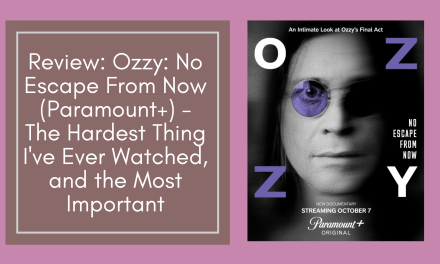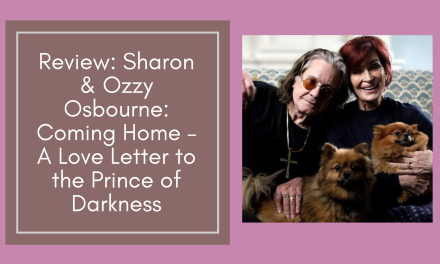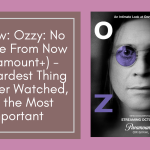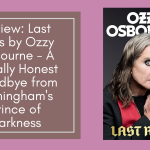As I write this article, I’m struck by a profound parallel between two moments that changed my life that are separated by 34 years, yet connected by grief, music, and the extraordinary evolution of technology. In November 1991, when the #LoveOfMyLife Freddie Mercury from Queen passed away at just 45, I was a heartbroken 17-year-old huge fan processing my grief through handwritten journals, pouring my emotions onto paper with a pen.
Last month, when news broke that Ozzy Osbourne had died at 76, I was just as devastated as when Freddie passed away in November 1991. But a big difference this time was being able to process, write, and instantly share my thoughts with the world through this blog within minutes of hearing the news.
The contrast couldn’t be starker, and it perfectly illustrates just how dramatically our technological landscape has transformed over the past three decades.
1991: The Analog World of Private Grief
When Freddie Mercury died on November 24, 1991, I was beyond devastated. As someone who had grown up with Queen from the moment I was born, Freddie’s death felt personal and profound. But in 1991, my grief was analogue and more private, and I processed my emotions through:
- Handwritten journals
I remember sitting at my desk in my childhood bedroom, fountain pen in hand, filling page after page with my thoughts and memories of Freddie. The physical act of writing was therapeutic – the scratch of pen on paper, the way tears would sometimes smudge the ink, the deliberate pace that forced me to really consider each word. These journals became sacred objects, holding not just my thoughts but the actual moment of their creation. I could flip through them weeks later and see exactly how my grief evolved, from raw devastation to gradual acceptance. - Physical letters to friends who shared my love of Queen
Writing letters was an art form in 1991. I’d carefully select stationery, craft my thoughts over multiple drafts, and then walk to the post-box knowing my words wouldn’t reach their destination for two or three days. There was something profound about that delay, it gave weight to what we shared. When replies arrived, often a week later, they felt like precious gifts. The anticipation of waiting for the postman was part of the grieving and healing process. - Telephone calls on landlines, often expensive long-distance calls to connect with fellow fans.
I’ll never forget the astronomical phone bills from calling other Queen fans around the country and even internationally. We’d plan these calls like military operations, knowing every minute cost money. But when you connected with someone who understood your grief over Freddie’s death, the cost seemed irrelevant. These conversations were intense and focused – no multitasking, no distractions, just pure human connection over copper wires. - Waiting for news from radio, television, or the next day’s newspapers
Information came in carefully curated packages. The 6 o’clock news, the morning paper, weekly music magazines. We’d gather around radios and televisions at specific times, creating shared moments of discovery. I remember staying up late to catch any mention of Freddie on late-night radio shows, and the ritual of going to the newsagent the morning after his death to buy every newspaper that covered the story. - Collecting physical memorabilia from record shops and newsagents
In the weeks following Freddie’s death, I scoured every record shop and magazine stand within miles. Special edition magazines, tribute records, posters – each item was a treasure hunt. These physical objects became shrines in my bedroom, tangible connections to Freddie’s memory that I could hold, smell, and arrange. Each purchase was deliberate and meaningful.
The intimacy of that analogue grief was both isolating and profound. My thoughts stayed private unless I chose to physically share them. There was time for reflection between feeling and expression, between writing and sharing. The physical world enforced a natural pause that allowed emotions to settle and deepen before being communicated.
2025: The Digital Age of Instant Connection
Fast forward to July 22, 2025, when Ozzy Osbourne passed away. Within minutes of the news breaking, I was able to:
- Research and verify the news through multiple online sources instantly
The moment I saw the first social media post about Ozzy’s death; I immediately opened multiple browser tabs. BBC News, CNN, Rolling Stone, TMZ, Variety – within thirty seconds I had confirmation from five reputable sources. I could cross-reference details, check official family statements, and even see real-time updates from the Osbourne family’s social media accounts. The speed of verification that would have taken hours or days in 1991 now takes mere minutes. - Write and publish a blog post to my website www.cybergeekgirl.co.uk immediately
I opened my WordPress dashboard and began typing while the news was still breaking. No need to find paper, no drafting and redrafting by hand. My thoughts flowed directly from my mind through my keyboard to a global platform. Within an hour of hearing the news, my tribute to Ozzy was live on the internet. The entire process from conception to publication took less time than it would have taken me to write a single handwritten page in 1991. - Share across social platforms – LinkedIn, Twitter, Facebook – reaching thousands instantly
With a few clicks, I could amplify my blog post across all my social networks simultaneously. Each platform allowed me to tailor the message – a professional reflection on LinkedIn, a heartfelt tribute on Facebook, a quick commemoration on Twitter. Within minutes, people were liking, sharing, and commenting from around the world. The reach was immediate and exponential – something that would have been impossible to achieve in 1991. - Connect with global communities of mourning fans in real-time
Facebook groups, Reddit communities, X/Twitter hashtags – suddenly I wasn’t grieving alone. Fans from Australia, Japan, Brazil, and everywhere in between were sharing memories, photos, and videos in real-time. We created an instant global wake for Ozzy, with thousands of participants sharing stories simultaneously. The isolation I felt when Freddie died was replaced by immediate community. - Access streaming tributes including full discographies, live performances and documentaries
Within minutes of hearing the news, I could pull up Ozzy’s entire catalogue on Spotify, watch Black Sabbath’s greatest performances on YouTube, and stream documentaries about his life. In 1991, if I wanted to hear “Paranoid,” I had to play the vinyl record I had of it or hope that a radio station would play it. Now, I could create an instant Ozzy memorial playlist and share it with fellow mourners worldwide. - Video call friends anywhere in the world to share the moment together
Using WhatsApp, Zoom and Teams I could see friends’ faces as we processed the news together. Geography became irrelevant, I was virtually present with Ozzy’s fans in different countries, sharing tears and memories as if we were in the same room. The human connection that required physical presence or expensive phone calls in 1991 was now free and instantaneous.
The speed and reach of digital grief is breathtaking. What once took days or weeks to communicate can now happen in minutes.
The Technology Evolution: A Personal Journey
As someone who has worked in cyber security for over a decade and witnessed the digital transformation of our world, this personal comparison feels especially poignant. In 1991:
- Home computers were still relatively rare
I remember being one of the few in my class with a home computer, a Texas Instruments TI/499, which seemed incredibly advanced at the time. It had 32KB of RAM and used cartridges for storage. Loading a simple program could take fifteen minutes, accompanied by the distinctive screech of data loading from the cartridges. The idea that I would one day carry a computer in my pocket that was millions of times more powerful would have seemed like pure science fiction back in 1991. - The internet was in its infancy, used mainly by academics and researchers
Most people had never heard of the World Wide Web. Email was exotic, bulletin board systems required dial-up modems and arcane knowledge, and the idea of “going online” to find information was foreign to most. When I wanted to research Queen or learn more about Freddie Mercury, I had to visit libraries, buy magazines, or hope to catch documentaries on television. Knowledge was scarce and precious. Today, researching anything about Ozzy Osbourne and Black Sabbath was instantaneous and at the tip of my fingers, but today, especially with the advent of AI and deepfakes, I have the added problem of fake news and determining/verifying what is real and what is not. - Mobile phones were bulky, expensive, and used only for calls
The few mobile phones that existed were the size of house bricks and cost a fortune to operate. They lived in cars or briefcases and were symbols of wealth rather than everyday communication tools. Text messaging didn’t exist for consumers, and the idea that you could carry the internet in your pocket was pure fantasy. If you wanted to reach someone, you had to plan ahead or hoped they were home when you called. - Publishing required physical media such as magazines, newspapers and books
Getting your writing published meant convincing gatekeepers at newspapers, magazines, or publishing houses. The barrier to entry was enormous, requiring connections, credentials, or exceptional luck. Even if you managed to get published, distribution was limited to whatever physical copies could be printed and distributed. Your reach was constrained by geography and print runs. - Music sharing meant physical cassettes, CDs, or radio recordings
Discovering new music required browsing record shops, listening to radio DJs, or getting recommendations from friends who could physically play songs for you. Making a mixtape for someone was an act of love that required hours of careful curation and recording. If you missed a song on the radio, you might never hear it again unless you bought the album or caught it on another broadcast.
Today, I carry more computing power in my smartphone than existed in entire university computer labs in 1991. My iPhone has over 128GB of storage and a processor that would have been considered a supercomputer three decades ago. I can:
- Research any topic instantly through search engines
Google has become my external brain, capable of answering any question within seconds. Want to know Ozzy’s exact birth date? December 3, 1948 – found in 0.23 seconds. Need the complete lineup for his final Black Sabbath concert? There it is, with video clips and setlists. Curious about the lyrics to “Crazy Train” or their meaning? Instant access to not just the words, but interviews where Ozzy explains the inspiration behind them. In 1991, answering these questions might have required trips to multiple libraries, phone calls to record companies, or weeks of waiting for magazine articles. I remember spending entire afternoons in the central library, hunting through music encyclopaedias and periodicals just to find basic biographical information about Queen. Now the world’s knowledge is literally at my fingertips, searchable, cross-referenced, and available 24/7. - Publish my thoughts to a global audience immediately
My blog at www.cybergeekgirl.co.uk gives me the same publishing power that major newspapers had in 1991, arguably more. I can write an article, embed high-resolution photos, add YouTube videos, create infographics, optimize it for search engines, and publish it to a potential audience of millions within minutes. WordPress handles the technical complexity that would have required a team of typesetters, editors, and distributors in the analog era. I can see real-time analytics showing readers from around the world, their engagement levels, and which sections resonate most. Social media integration means my content can go viral organically – something impossible in the era of print media gatekeepers. - Stream any song, anywhere, anytime
Spotify, Apple Music, YouTube Music, and dozens of other platforms give me instant access to virtually every song ever recorded. Ozzy’s complete discography, rare B-sides, live bootlegs from the 1970s, covers by tribute bands, isolated vocal tracks, instrumental versions – it’s all there within seconds of thinking about it. I can create instant playlists mixing Black Sabbath with Queen, share them globally, and see what others are listening to in real-time. In 1991, if I wanted to hear “Paranoid,” I had to hope I owned the vinyl, cassette, or CD, or wait for a radio DJ to play it. Building a music collection required physical space, significant money, and years of hunting through record shops. - Connect with like-minded people across the world
Through Facebook groups, Reddit communities, Discord servers, professional networks like LinkedIn, and specialized platforms, I can find and connect with fellow Queen fans in Tokyo, cyber security professionals in Tel Aviv, autism advocates in São Paulo, or Black Sabbath collectors in Birmingham. These aren’t superficial connections either – I’ve developed genuine friendships with people I’ve never met in person but who share deep connections through our common interests. Geography has become completely irrelevant for building meaningful relationships. I’m part of a Queen fan group that includes members from six continents who organise virtual listening parties and share rare recordings in real-time. - Create multimedia content with professional quality tools in my pocket
My smartphone has 4K video recording, professional-grade audio capture, and editing capabilities that rival what major television studios had in 1991. I can shoot a video about cybersecurity best practices, edit it with multiple angles and graphics, add professional-quality audio, create custom thumbnails, and publish it to YouTube – all from the same device. Apps like Canva give me access to millions of stock photos, professional templates, and design tools that would have cost thousands of pounds in licensing fees and equipment just a few years ago. Adobe Creative Suite, which once required powerful desktop computers, now runs on my phone with cloud synchronization across all devices.
The Double-Edged Sword of Progress
This technological evolution brings both profound gifts and significant losses:
What we’ve gained:
- Instant connection during moments of grief and celebration
When David Bowie died in 2016, within hours there were virtual vigils happening simultaneously across Facebook, Twitter, and Instagram. Fans shared stories, photos, and memories in real-time, creating a global community of mourning that provided immediate comfort and connection. I watched people from different continents sharing their personal encounters with Bowie’s music, creating an organic, worldwide tribute that lasted for days. The isolation that often accompanies grief – that crushing feeling that you’re alone in your loss – has been replaced by the ability to find thousands of others who understand your exact emotional state, regardless of where they live. When Ozzy passed, I wasn’t just reading about other fans’ grief; I was participating in a global conversation, sharing memories and finding solace in our collective loss. - Global communities that transcend geographical boundaries
I’m an active member of a Queen fan group on Facebook with 50,000 members from every continent, where rare recordings are shared daily and fans collaborate on tribute projects. Through LinkedIn, I connect with cyber security professionals from major corporations worldwide, sharing threat intelligence and best practices in real-time. My autism advocacy work connects me with neurodivergent individuals across cultures and time zones, providing support networks that would have been impossible to maintain in 1991 without enormous expense and effort. These communities provide emotional support, professional development, and friendships that enrich my life in ways I never could have imagined in the analogue world. - Preservation of memories through digital archives and cloud storage
My entire digital life is backed up across Google Drive, iCloud, and Dropbox, ensuring that photos, videos, and writings survive house fires, floods, or hardware failures. More importantly, platforms like YouTube and Spotify preserve performances and music that might have been lost forever in the analogue age. Rare live recordings of Queen that existed on a handful of deteriorating bootleg tapes in 1991 are now preserved in pristine digital quality and available to millions of fans worldwide. Concert footage that would have been seen once on television and then lost to time is now permanently archived and searchable. - Creative tools that democratise publishing and content creation
Anyone with a smartphone can now create content that rivals professional productions from decades past. Podcasting equipment that would have cost thousands in 1991 is now available as free software on any phone. Blogging platforms, video editing apps, graphic design tools, and social media have led to an explosion of diverse voices and perspectives that never would have been heard through traditional media gatekeepers. I’ve seen brilliant cybersecurity insights from self-taught enthusiasts, moving autism advocacy from teenagers, and innovative tech solutions from people who would never have had access to traditional publishing channels. - Access to information that would have been impossible to obtain in 1991
I can watch Freddie Mercury’s final interview from 1987, read peer-reviewed medical research about Parkinson’s disease to understand Ozzy’s struggles, access real-time government statistics about cyber security threats, learn complex technical skills through free online courses, or explore any topic imaginable within minutes. The democratization of information has educated and empowered people in ways that were unimaginable three decades ago. University-level courses from MIT and Stanford are available for free online. Technical documentation that was once proprietary and expensive is now open-source and accessible to anyone with an internet connection.
What we’ve lost:
- Time for reflection between feeling and sharing
The immediacy of digital communication often means we react before we’ve fully processed our emotions or thoughts. In 1991, the time it took to handwrite a letter, find stamps, and walk to a post-box enforced a natural pause that allowed for deeper consideration. I would often write drafts of letters and then reconsider them the next day, leading to more thoughtful communication. Now we can tweet our first emotional reaction within seconds of an event, sometimes leading to misunderstandings, public embarrassment, or relationships damaged by hasty words. The “send” button has eliminated the cooling-off period that analogue communication naturally provided. - Privacy of grief – everything can become public instantly
Personal moments that would have remained private in 1991 can now be broadcast to the world accidentally or impulsively. A momentary lapse in judgment during emotional distress can result in oversharing that follows us forever through screenshots and digital archives. The boundary between public and private has blurred beyond recognition, and we must actively protect our emotional privacy rather than having it protected by default through physical limitations. Even private messages can be screenshot and shared, making truly confidential emotional expression increasingly difficult. - Physical artifacts – the tangible connection to memories
Digital photos displayed on screens don’t carry the same emotional weight as physical photographs you can hold, frame, and pass down through generations. Streaming music lacks the ritualistic experience of putting a vinyl record on the turntable, reading liner notes, and appreciating album artwork at full size. The sensory experience of flipping through handwritten journals, feeling the texture of the paper, seeing how handwriting changes with emotion – these tactile connections to memory have been largely replaced by scrolling through identical-looking screens. There’s something irreplaceably intimate about physical objects that held personal meaning. - Focused attention – we’re constantly distracted by notifications
In 1991, when I sat down to write in my journal about Freddie Mercury, that activity commanded my complete, undivided attention. The phone might ring, but there were no email notifications, social media alerts, or push notifications competing for my mental bandwidth. Now, writing is constantly interrupted by the digital demands of dozens of apps and platforms. Deep focus and sustained attention have become rare and precious commodities. Even during moments of grief or celebration, we’re pulled away from the experience by the constant stream of digital interruptions. - The art of patient waiting for news, information, or communication
There was something profoundly valuable about the anticipation of waiting for a letter to arrive, a favourite magazine to be published, or a beloved song to come on the radio. That patience cultivated appreciation and made information feel more precious when it finally arrived. The delayed gratification of analogue communication made every piece of correspondence feel significant. Instant gratification has made us less tolerant of delay, less appreciative of what we receive, and perhaps less capable of sustained anticipation and the joy that comes with finally receiving something we’ve waited for.
Lessons from Both Eras
Having experienced profound grief in both the analog and digital ages, I’ve learned valuable lessons:
From 1991: The importance of private reflection, the power of handwritten thoughts, and the deep connections formed through slower, more intentional communication.
From 2025: The comfort of instant community during difficult times, the ability to preserve and share memories immediately, and the power of global connection.
The key is finding balance – using digital tools to enhance human connection while preserving the space for private reflection that handwritten journals once provided.
Looking Forward: Technology Serving Humanity
As we continue to advance technologically, I hope we can learn from both eras. Technology should serve our humanity, not replace it. Whether we’re grieving the loss of musical legends like Freddie Mercury and Ozzy Osbourne, or celebrating life’s joys, the goal should be authentic connection and meaningful expression.
In my work in cyber security and as someone who is #OpenlyNeurodivergent, I’ve learned that technology is most powerful when it amplifies our human capacity for empathy, creativity, and connection. The same tools that allowed me to instantly share my grief about Ozzy’s passing also allow me to advocate for mental health awareness, support other neurodiverse individuals, and build global communities around cybersecurity.
The handwritten journals of 1991 and the instant blog posts of 2025 both serve the same fundamental human need: to process our experiences, connect with others, and find meaning in both joy and sorrow.
Fortune favours the bold, as I learned from Freddie Mercury’s story, and sometimes being bold means knowing when to embrace new technology and when to honour the wisdom of analogue reflection.
What are your memories of how you processed grief or major news in 1991 versus today? I’d love to hear your thoughts in the comments below.

























